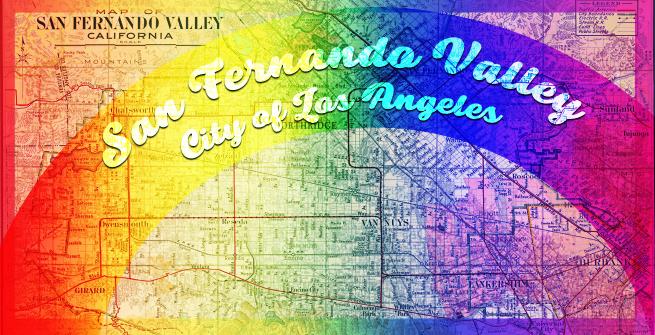When thinking of LGBTQ+ Los Angeles in the 20th century, one might conjure up a mental map of the L.A. basin from Long Beach to Boyle Heights, with not much to the north. However, the San Fernando Valley, known as the sleepier, more conservative side of the Santa Monica Mountains, should not be overlooked. From its nightlife to professional organizations to festivities, the Valley historically has hosted a range of opportunities for queer people to meet, network, and stay informed.
The North Hollywood and Studio City area has the richest queer history in the Valley. It was home to several bars and clubs that catered to LGBTQ+ customers as early as mid-century. Club Laurel, for example, was owned by entertainer Beverly Shaw from 1957 to 1968 and was a known lesbian destination on Ventura Blvd. Angelenos seeking gay-friendly night spots away from the more conspicuous neighborhoods along Sunset Blvd could find a greater sense of safety in the Valley, which some mistakenly consider to be outside of Los Angeles city limits. "They were out of the City of Los Angeles. They were in the County and that was less risky. I'd be fired by my agency in a snap if I'd been caught in a bar raid in the City," said a television ad executive in an interview with Lillian Faderman*, co-author of Gay L.A.: A History of Sexual Outlaws, Power Politics, and Lipstick Lesbians.
Queer nightlife also extended into the western San Fernando Valley as far back as the 1960s. Tarzana, for example, was once home to Dusty Trail Tavern. Tourists looking for bars and nightclubs to find community could consult the International Guild Guide, a directory for queer tourists which was first published in the mid-1960s and gave specifics such as which establishments allowed same-sex dancing.
In the mid-1960s, the raids on gay bars in Los Angeles became so concerning that the Tavern Guild of Southern California was formed, headquartered at 11012 Ventura Blvd. On December 19, 1966, the Guild hosted a Christmas dinner at the Tahitian Restaurant in the Valley in an attempt to foster better relations between the police and the queer community. According to the magazine Tangents, the event failed in its mission, and in January 1967 the Guild helped circulate the story of the mass arrests at The Black Cat in Silverlake, a pre-Stonewall raid that resulted in protest.
The drag scene has also existed in the Valley since at least the 1950s. Beverly Shaw wore a tuxedo at Club Laurel. To see shows with drag queens, people went to the Queen Mary, which opened in Studio City in the early 1960s. Angelenos could also join the Royal Court of San Fernando Valley, part of the Imperial Council of Courts, and attend coronation balls in drag. The Imperial Council, which got its start in San Francisco in the mid-1960s, is now a part of the International Court System and has active chapters in and outside of California. The courts raise funds for and provide assistance to the queer community and the community at large, and members can earn titles such as Emperor and Empress.

If drag balls were not to one’s taste, there was Pioneer Days, a festival held north of the Cahuenga Pass starting in 1979. This western-themed carnival was hosted by the Valley Business Alliance, an organization formed for gay and lesbian business people and professionals. VBA also sponsored water volleyball tournaments in Sylmar starting in the mid-1980s. Proceeds from these events went to organizations serving the queer community. (Eventually, the Valley Business Alliance evolved into today’s Los Angeles LGBTQ Chamber of Commerce).
Valley-based periodicals also kept Angelenos informed about the gay community. The Now Times, a feminist newspaper that featured gay content, was published in Van Nuys. From the Valley’s southeast came Frontiers Newsmagazine and Tangents, the latter being an offshoot of ONE Magazine. Tangents was published out of the Homosexual Information Center, also known as The Tangents Group, at 3473 1/2 Cahuenga Blvd. It was at this location that Tangents editor Don Slater hosted the first meeting of the Los Angeles Gay Liberation Front, which formed on December 14, 1969.
Angelenos in the 1960s and 1970s could also tune in to KPFK for a pioneering Valley-based radio program called Homosexuality Today. The KPFK station also offered the gay and lesbian programs IMRU and Radio GLLU. The latter was a monthly show produced by Gay and Lesbian Latinos Unidos, which enjoyed a decade-long run beginning in 1986.

The transgender community also made history in the Valley in the 1990s. In February 1995, the Center for Sex Research of California State University, Northridge, hosted the first International Congress on Gender, Cross-Dressing, and Sex Issues in Van Nuys. This conference brought the professional, academic, and transgender world together to discuss the needs of trans and gender non-conforming people.
To learn more about LGBTQ+ history, the Los Angeles Public Library offers you access to the invaluable database Archives of Human Sexuality and Identity, which is accessible from home with your library card. And as L.A. celebrates Transgender History Month, remember that queer identities are not limited by geography and that there is and has been for a long time more “over the hill."
*pg 98, Gay L.A.: A History of Sexual Outlaws, Power Politics, and Lipstick Lesbians, by Lillian Faderman and Stuart Timmons

